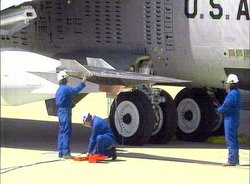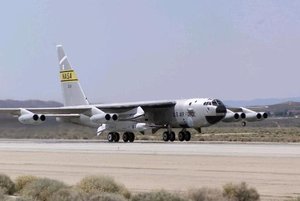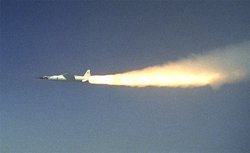Boeing X-43
|
|

A winged booster rocket with the X-43 itself at the tip, called a "stack", is launched from a carrier plane. After the booster rocket (a modified first stage of the Pegasus rocket) brings the stack to the target speed and altitude, it is discarded, and the X-43 flies free using its own engine, a scramjet.
The initial version, the X-43A, was designed to operate at speeds greater than Mach 7, about 8,050 km/h (5,000 mph) at altitudes of 100,000 feet (30,000 m) or more. The X-43A is a single-use vehicle and is designed to crash into the ocean without recovery. Three of them have been built: the first was destroyed; the other two have successfully flown, with the scramjet operating for approximately 10 seconds, followed by a 10 minute glide and intended crash.
The first flight in June 2001 failed when the stack spun out of control about 11 seconds after the drop from the B-52 carrier plane. It was destroyed by the range safety officer, and it crashed into the Pacific Ocean. NASA attributed the crash to several inaccuracies in data modeling for this test, which led to an inadequate control system for the particular Pegasus used.
The second X43-A flew in at about Mach 7 on March 27, 2004. This test made the X-43A the fastest free flying air-breathing aircraft in the world.
The third flight of a Boeing X-43A set a new speed record of 7,000 mph (11,200 km/h), or Mach 9.8, on November 16, 2004. It was boosted by a modified Pegasus rocket which was launched from a Boeing B-52 at 13,157 meters (40,000 feet). After a free flight where the scramjet operated for about ten seconds, the craft made a planned crash into the Pacific ocean off the coast of southern California.
The most recent success in the X-plane series of aircraft, the X-43 is part of NASA's Hyper-X program, involving the American space agency and contractors such as Boeing, MicroCraft Inc, Orbital Sciences Corp and General Applied Science Laboratory (GASL). The budget for this ongoing program is approximately $250 million. A follow-on program to develop the X-43C was planned but has now been suspended.
| Contents |
The craft
The X-43A aircraft was a small unpiloted test vehicle measuring just over 12 feet in length. The vehicle was a lifting body and waverider design, where the body of the aircraft provides a significant amount of lift for flight, rather than relying on wings. The aircraft weighed roughly 3,000 pounds or about 1,300 kilograms. The X-43A was designed to be fully controllable in high-speed flight, even when gliding without propulsion. However, the aircraft was not designed to land and be recovered. Test vehicles crashed into the Pacific Ocean when the test was over.
Traveling at Mach speeds produces a lot of heat due to friction from wind resistance. At high Mach speeds, heat can become so intense that metal portions of the airframe melt. The X-43A compensated for this by cycling water behind the leading edges of the aircraft, cooling those surfaces. In tests, the water circulation was activated at about Mach 3. In the future, fuel may be cycled through such areas instead, much like what is currently done in many liquid-fuel rocket nozzles and high speed planes such as the SR-71.
The engine
Wind_tunnel_x-43.jpg
The craft was created to develop and test an exotic type of engine called a supersonic-combustion ramjet, or "scramjet," an engine variation where external combustion takes place within air that is flowing at supersonic speeds. The X-43A's developers designed the aircraft's airframe to positively affect propulsion, just as it affects aerodynamics: in this design, the forebody is a part of the intake airflow, while the aft section functions as a nozzle.
The engine of the X-43A was primarily fueled with hydrogen. In the successful test, about two pounds (or roughly one kilogram) of the fuel was used. However, because hydrogen poses certain difficulties in storage, transport, and even production, further X-43 versions were planned to use more commonly available hydrocarbon fuels instead. Unlike rockets, scramjet-powered vehicles do not carry oxygen onboard for fueling the engine. Removing the need to carry oxygen significantly reduces the vehicle's size and weight. In the future, such lighter vehicles could bring heavier payloads into space or carry payloads of the same weight much more efficiently.
Scramjets only operate at hypersonic speeds in the range of Mach 6 or higher, so rockets or other jet engines are required to initially boost scramjet-powered aircraft to this base velocity. In the case of the X-43A, the aircraft was accelerated to high speed with a Pegasus rocket launched from a converted B-52 Stratofortress bomber. The combined X-43A/Pegasus vehicle was referred to as the "stack" by the program's team members.
The engines in the X-43A test vehicles were specifically designed for a certain speed range, only able to compress and ignite the fuel-air mixture when the incoming airflow is moving as expected. The first two X-43A aircraft were intended for flight at approximately Mach 7, while the third was to fly at approximately Mach 10.
The X-43A's successful second flight made it the fastest free flying air-breathing aircraft in the world, though it was preceded by an Australian HyShot as the first operating scramjet engine flight. While still attached to its launching missile, the HyShot flew in descending powered flight in 2002.
Tests
NASA's first X-43A test on June 2, 2001 failed because the Pegasus booster lost control about 13 seconds after it was released from the B-52 carrier. The rocket experienced a control oscillation as it went transonic, eventually leading to the failure of the rocket's starboard elevon. This caused the rocket to deviate significantly from the planned course, so the stack was destroyed by onboard explosives as a safety precaution. An investigation into the incident stated that imprecise information about the capabilities of the rocket as well as its flight environment contributed to the accident, though no single factor could ultimately be blamed for the failure.In the second test, the Pegasus fired successfully and released the test vehicle at an altitude of about 95,000 feet. After separation, the engine's air intake was opened, the engine ignited, and the aircraft then accelerated away from the rocket. Fuel was flowing to the engine for eleven seconds, a time in which the aircraft traveled more than 15 miles (24 km). After burnout, controllers were still able to maneuver the vehicle and manipulate the flight controls for several minutes as the aircraft was slowed down by wind resistance and took a long dive into the Pacific. Peak speed was at burnout of the Pegasus but the scramjet engine did accelerate the vehicle in climbing flight, after a small drop in speed following separation.
NASA flew a third version of the X-43A on November 16, 2004, achieving a speed of approximately Mach 10 and further testing the ability of the vehicle to withstand the heat loads involved.
Future development
Other X-43 vehicles were designed, but as of November 2004 appear to have been suspended. They were expected to have the same basic body design as the X-43A, though the aircraft were expected to be moderately to significantly larger in size.
X-43B
The next letter down the list, the X-43B, was expected to be a full-size vehicle, incorporating a turbine-based combined cycle (TBCC) engine or a rocket-based combined cycle (RBCC) ISTAR engine. Jet turbines or rockets would initially propel the vehicle to supersonic speed. A ramjet might take over starting at Mach 2.5, with the engine converting to a scramjet configuration at approximately Mach 5. If the vehicle was heading to space, it might activate rockets once the atmosphere became thin.
X-43C
The X-43C would have been somewhat larger than the X-43A and was expected to test the viability of hydrocarbon fuel, possibly with the HyTech engine. While most scramjet designs have used hydrogen fuel, HyTech runs with conventional kerosene-type hydrocarbon fuels, which are more practical for support of operational vehicles. The building of a full-scale engine was planned which would use its own fuel for cooling. The engine cooling system would have acted as a chemical reactor by breaking long-chain hydrocarbons into short-chain hydrocarbons for a rapid burn.
The X-43C was indefinitely suspended (http://www.aviationnow.com/avnow/news/channel_aerospacedaily_story.jsp?id=news/eng03194.xml) in March 2004. The linked story reports the project's indefinite suspension and the appearance of Rear Admiral (RADM) Craig Steidle before a House Space and Aeronautics subcommittee hearing on March 18, 2004.
X-43D
The X-43D would have expanded the speed envelope to approximately Mach 15.
External links
- NASA: X-43 (http://www.nasa.gov/missions/research/x43-main.html)
- Dryden Flight Research Center (http://www.dfrc.nasa.gov/)
- Boeing: Hyper-X X-43A (http://www.boeing.com/phantom/hyperx.html)
- Orbital's Hyper-X Rocket Successfully Launches NASA's X-43A Scramjet To Mach 10 (http://www.orbital.com/Template.php?Section=News&NavMenuID=32&template=PressReleaseDisplay.php&PressReleaseID=484)
References
- X-43 Hyper-X Program. (http://www.globalsecurity.org/space/systems/x-43.htm) GlobalSecurity.org
- NASA Seeks New Frontier in Jet Engines. (http://www.nytimes.com/2004/03/27/science/27JET.html) New York Times.
| Related content | |
|---|---|
| Related Development | |
| Similar Aircraft | |
| Designation Series | |
| Related Lists | |
|
Lists of Aircraft | Aircraft manufacturers | Aircraft engines | Aircraft engine manufacturers Airports | Airlines | Air forces | Aircraft weapons | Missiles | Timeline of aviation |


